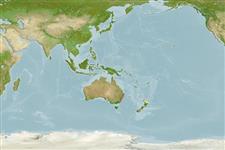Environment: milieu / climate zone / depth range / distribution range
Écologie
marin; eau douce; saumâtre démersal; catadrome; profondeur 1 - 10 m (Ref. 9812). Temperate; 10°S - 44°S
Southwest Pacific: Australia including the Lord Howe and Norfolk islands. Probably also the southern extreme of Queensland (Ref. 9812).
Taille / Poids / Âge
Maturity: Lm ? range ? - ? cm
Max length : 40.0 cm TL mâle / non sexé; (Ref. 9812); common length : 20.0 cm TL mâle / non sexé; (Ref. 9812)
Description synthétique
Morphologie | Morphométrie
Épines dorsales (Total): 4; Épines anales 3; Rayons mous anaux: 9. Dark olive-green or reddish brown dorsally, greenish wash on upper flanks, lower flanks silvery (Ref. 9812). Gold blotch on operculum (Ref. 9812). Golden-yellow iris around dark eye (Ref. 9812). Fins greenish brown, except anal fin with white margin (Ref. 9812). Black spot at base of pectoral fin (Ref. 9812).
Form schools in shallow coastal waters and lower estuaries. Found in freshwater during its first year, seldom thereafter (Ref. 9812). Spawn near estuary mouths or in the sea (Ref. 9812). Oviparous, eggs are pelagic and non-adhesive (Ref. 205). Feed on small crustaceans and mollusks as well as microscopic algae (Ref. 2109). Marketed fresh or filleted (Ref. 9812).
Life cycle and mating behavior
Maturité | Reproduction | Frai | Œufs | Fécondité | Larves
Francis, M.P., 1993. Checklist of the coastal fishes of Lord Howe, Norfolk, and Kermadec Islands, Southwest Pacific Ocean. Pac. Sci. 47(2):136-170. (Ref. 8879)
Statut dans la liste rouge de l'IUCN (Ref. 130435)
Menace pour l'homme
Harmless
Utilisations par l'homme
Pêcheries: commercial
Plus d'informations
Noms communsSynonymesMétabolismePrédateursÉcotoxicologieReproductionMaturitéFraiRassemblement de ponteFéconditéŒufsDéveloppement de l'œuf
Taille/ÂgeCroissanceLongueur-poidsLongueur-longueurFréquences de longueursMorphométrieMorphologieLarvesDynamique des populations larvairesRecrutementAbondanceBRUVS
RéférencesAquacultureProfil d'aquacultureSouchesGénétiqueElectrophoresesHéritabilitéPathologiesTraitementNutrientsMass conversion
CollaborateursImagesStamps, Coins Misc.SonsCiguateraVitesseType de nageSurface branchialeOtolithesCerveauxVision
Outils
Articles particuliers
Télécharger en XML
Sources Internet
Estimates based on models
Preferred temperature (Ref.
123201): 18.1 - 23.3, mean 21.2 °C (based on 60 cells).
Phylogenetic diversity index (Ref.
82804): PD
50 = 1.0000 [Uniqueness, from 0.5 = low to 2.0 = high].
Bayesian length-weight: a=0.01175 (0.00558 - 0.02474), b=2.96 (2.79 - 3.13), in cm total length, based on LWR estimates for this (Sub)family-body shape (Ref.
93245).
Niveau trophique (Ref.
69278): 3.1 ±0.41 se; based on food items.
Résilience (Ref.
120179): Haut, temps minimum de doublement de population inférieur à 15 mois (Preliminary K or Fecundity.).
Fishing Vulnerability (Ref.
59153): Low vulnerability (21 of 100).
Nutrients (Ref.
124155): Calcium = 76.3 [33.4, 166.4] mg/100g; Iron = 0.529 [0.249, 1.045] mg/100g; Protein = 18.9 [17.3, 20.7] %; Omega3 = 0.852 [0.402, 1.824] g/100g; Selenium = 9.94 [4.07, 23.65] μg/100g; VitaminA = 8.37 [2.27, 34.03] μg/100g; Zinc = 0.761 [0.504, 1.134] mg/100g (wet weight);
